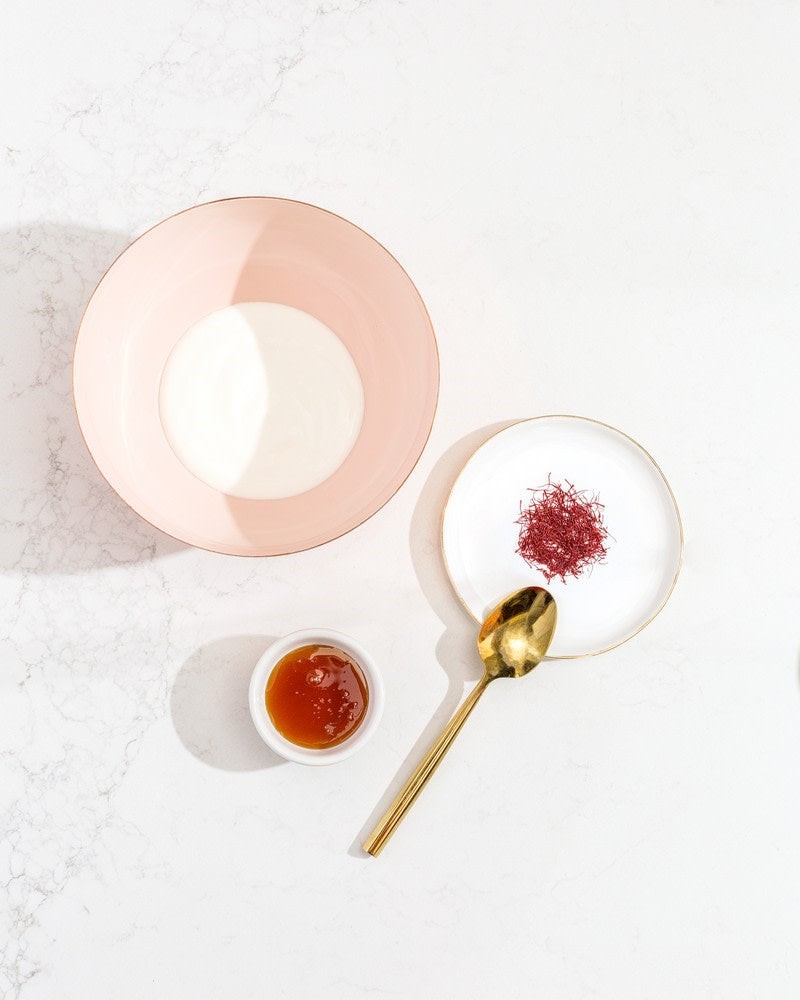More recently, saffron has attracted a renewed interest for its use in cosmetics.Since ancient times, saffron has been used for cosmetic purposes, absorbed in infusion or even in the cutaneous application, mixed with fat or macerated in donkey milk, for its eternal youthful properties.
Radiant Like The Sun

Even Cleopatra used it in her beauty products. In traditional Iranian medicine, saffron can improve the complexion and can be used to treat erysipelas. In traditional Greek medicine, it can refresh the skin of the face and relieve the liver of the domination of bile and treat acne, skin diseases, and wounds. In another category, Hindu women used saffron to make the Bindi, the yellow dot on the forehead. It is, in a way, a third eye symbolizing good fortune and conscience. Nowadays, several studies have studied saffron tepals as rich in crocin and kaempferol, thus representing an important source of bioactive compounds for potential cosmetic formulations. Besides the antioxidant properties, saffron presents multiple interests for cosmetic applications. The most promising activities are listed hereafter.
Anti-UV agent
Prolonged exposure to the sun is extremely harmful because it puts the skin in contact with UV rays, known to cause severe lesions. Saffron is known to have anti-sun effects that can protect the skin from harmful UV rays. Studies show that saffron lotion may be a better sunscreen than homosalate (an organic compound used in some sunscreens). Thus, saffron can be used as a natural UV absorbing agent. In addition to the antisolar and moisturizing properties of saffron, the prevention of skin cancers by saffron because of its antioxidant properties, is also essential.
Reduces the redness of dark spots
Saffron is known to reduce the pigment called melanin and it is very effective as a lightening agent for the skin. A formulation containing saffron extract caused significant depigmentation and anti-rhythmic effects on human skin.

Anti-ageing and anti skin diseases effect
In traditional herbal cosmetics, saffron can be soaked with a few basil leaves to treat blemishes such as acne. A mixture of soaked saffron strands with virgin coconut oil, or olive oil, and a bit of raw milk is an effective way to exfoliate and improve blood circulation on face skin. Saffron is known to reduce a skin condition called erythema, characterized by inflammation, redness, or rash. Saffron is also rich in antioxidants expected to inhibit the expression of markers of inflammation such as tumor necrosis factor (TNF) and interleukin. An application of the formulation containing 3% saffron extract to human skin may be helpful in the management of melanoma. Clinical trials have also shown in studies that saffron has anti-pruritic and skin-promoting effects.
Perfumery
Once dried, the spice releases a pleasant aroma described by Aristophanes as a “sensual smell” admired by the Greeks. It is from safranal, which is the main odoriferous compound of saffron, that we gather the note “saffron”. In ancient Greece, saffron was a royal dye used as a perfume in salons, courts, theatres, and bathrooms. Later, its use spread among ordinary people. Additionally, during the Parthian Dynasty, they used saffron among the ingredients of a royal scent, which included a refreshing oil facial for kings and ritual leaders. Today, we find this woody, sweet note and harmonious in the composition of different perfumes, both feminine and masculine, with an original and exotic potential.
Saffron as natural pigments in cosmetics
Historically, plant pigments such as curcumin, beet anthocyanins, carotenoids from peppers, chlorophyll from green leaves and saffron, have been used to color food and cosmetics for centuries. Nowadays, many commercially used cosmetics are made with synthetic colorants, which can cause side effects due to prolonged use. However, the current trend matches healthy natural ingredients incorporated within these cosmetic products. In cosmetics, saffron has been used at low levels due to its high cost. It has been used as a substitute for turmeric, where light exposure would cause fading of turmeric. It is also used as a substitute for tartrazine.
Anti obesity effects
Antioxidant-rich saffron compounds may modulate obesity and associated metabolic disorders. They can be potentially useful in the prevention, control, and management of weight gain and obesity of individuals. Despite the lack of supporting evidence on the possible weight loss effect of saffron in obese individuals, current knowledge about the properties of saffron suggests that saffron supplementation will be at least responsible for lowering the risk of over snacking-diet associated with obesity or promoting weight loss in overweight individuals. Due to the lack of research on evaluating the efficacy of saffron as an anti-obesity medication and clarifying the possible mechanism of action, both pre-clinical and clinical studies are warranted to demonstrate its full health potential.

